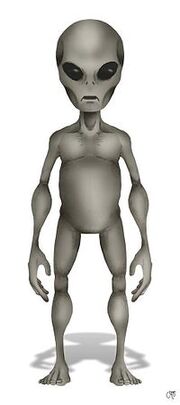Mars has been the prime target of extra-terrestrial life for many centuries.
Before Viking[]

A grey. Viking has subsequently ruled out such a creature, but conspiracy theories say that they left Mars for an extra solar planet to establish a colony.
Mars' polar ice caps were observed as early as the mid-17th century, and they were first proven to grow and shrink alternately, in the summer and winter of each hemisphere, by William Herschel in the latter part of the 18th century. By the mid-19th century, astronomers knew that Mars had certain other similarities to Earth, for example that the length of a day on Mars was almost the same as a day on Earth. They also knew that its axial tilt was similar to Earth's, which meant it experienced seasons just as Earth does — but of nearly double the length owing to its much longer year. These observations led to the increase in speculation that the darker albedo features were water, and brighter ones were land. It was therefore natural to suppose that Mars may be inhabited by some form of life.
In 1854, William Whewell, a fellow of Trinity College, Cambridge, who popularized the word scientist, theorized that Mars had seas, land and possibly life forms. Speculation about life on Mars exploded in the late 19th century, following telescopic observation by some observers of apparent Martian canals — which were later found to be optical illusions. Despite this, in 1895, American astronomer Percival Lowell published his book Mars, followed by Mars and its Canals in 1906, proposing that the canals were the work of a long-gone civilization. This idea led British writer H. G. Wells to write The War of the Worlds in 1897, telling of an invasion by aliens from Mars who were fleeing the planet’s desiccation.
Spectroscopic analysis of Mars' atmosphere began in earnest in 1894, when U.S. astronomer William Wallace Campbell showed that neither water nor oxygen were present in the Martian atmosphere. By 1909 better telescopes and the best perihelic opposition of Mars since 1877 conclusively put an end to the canal hypothesis.
However, this was all ruled out by the Viking landers in 1976. They found no aliens, no canals, and no water. If life exists, it will be in the form of primitive microbes, not greys or reptilians.